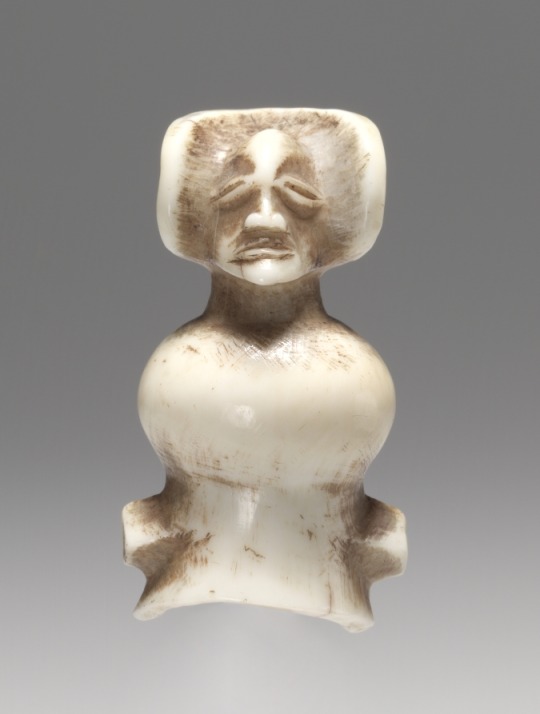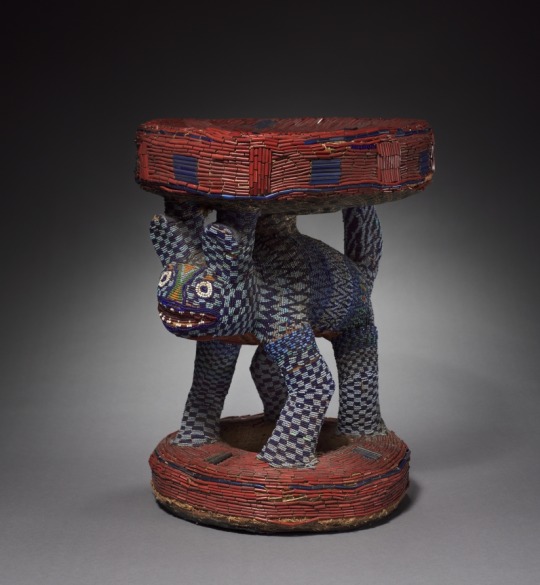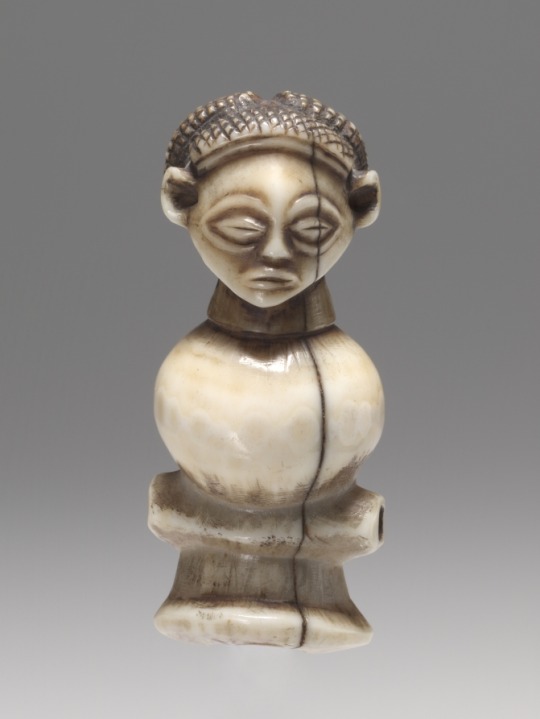Photo

Male Figure of a Pair, late 1800s-early 1900s, Cleveland Museum of Art: African Art
Although this pair has been attributed to the Ngbandi, many of the style characteristics identified as typical of that culture are in fact shared with its neighbors the Ngbaka-Minagende, among others. Carving of paired figures is quite well documented among the Ngbaka-Minagende, where such sculptures are said to represent the mythical ancestor Seto and his sister-wife, Nabo. But field-based research cannot confirm the existence of figurative couples among the Ngbandi. Were all such Ngbandi-style couples created by Ngbandi artists for a neighboring Ngbaka-Minagende community or another Ubangi group? Or do they instead refer to a more localized tradition that was never documented by foreign observers?
Size: Overall: 45 x 15.5 x 9.2 cm (17 11/16 x 6 1/8 x 3 5/8 in.)
Medium: wood, copper, glass beads, iron, fabric
https://clevelandart.org/art/2010.459.1
41 notes
·
View notes
Photo

Necklace Ornament, 13th–16th century, Metropolitan Museum of Art: Arts of Africa, Oceania, and the Americas
Gift of the Estate of Samuel L. M. Barlow, 1889
Size: L. ¾ in. (1.9 cm)
Medium: Gold
https://www.metmuseum.org/art/collection/search/307495
162 notes
·
View notes
Photo

Whistle, late 1800s, Cleveland Museum of Art: African Art
Carved out of ivory or wood in a variety of shapes, Chokwe whistles often bear miniature, stylized renderings of masks. Cikunza, the "patron saint" of the boys' initiation into manhood, is depicted with a pointed extension imitating the horn of a road antelope, symbolizing the fertility spirit. Typically such whistles were used by men during the hunt to communicate with their co-hunters and to call their dogs. They were either worn attached to a string as a necklace or tied to a spear.
Size: Overall: 5.7 x 3.2 cm (2 1/4 x 1 1/4 in.)
Medium: carved ivory
https://clevelandart.org/art/1915.442
26 notes
·
View notes
Photo

Knife Case, ca. 1843, Metropolitan Museum of Art: Arts of Africa, Oceania, and the Americas
Ralph T. Coe Collection, Gift of Ralph T. Coe Foundation for the Arts, 2011
Size: H. 12 ½ x W. 2 ¾ in. (31.8 x 7 cm)
Medium: Native-tanned skin, glass, silk, wool
https://www.metmuseum.org/art/collection/search/319107
84 notes
·
View notes
Photo

Male Figure (Ofika), late 1800s or early 1900s, Cleveland Museum of Art: African Art
Figures such as this, known as ofika, were central to the initiation practices and the enforcement of laws among the all-male Lilwa association, a hierarchical organization that served educational, judicial, political, economic, and ritual functions among the Mbole. Meant to instill a moral code and to act as a cautionary symbol during initiation for Lilwa novices, ofika figures are believed to represent criminals who were ritually hanged for transgressions against Lilwa laws. The figure’s encrusted surface imitates how members covered their bodies with a substance made of ashes and palm oil during burial rites.
Medium: Wood
https://clevelandart.org/art/2016.33
15 notes
·
View notes
Photo

Fertility Figure, 1800s-1900s, Cleveland Museum of Art: African Art
Fertility figures like these were used during the initiation ceremonies of pubescent girls. Integrating talismanic materials in their fabrication, the figures were meant to guarantee fertility and prevent or cure barrenness--a gourd’s womblike shape and the seeds within symbolize fecundity. They are sometimes also called "child figures" because a young bride would care for them as she would for her future children, carrying them on her back and sleeping with them until her first child was born. [Constantine Petridis Cleveland Museum of Art, (4/16/11-2/26/12); "The Art of Daily Life: Portable Objects from Southeast Africa"]
Size: Overall: 25.4 cm (10 in.)
Medium: wood, glass beads, fiber
https://clevelandart.org/art/2010.208
12 notes
·
View notes
Photo

The Fourth Month, A Lady of the Enkyō Era (1744-48), from the series Thirty-six Elegant Selections, Mizuno Toshikata, 1894, Cleveland Museum of Art: Japanese Art
Medium: Woodblock print, ink and color on paper
https://clevelandart.org/art/2017.72
228 notes
·
View notes
Photo

Statuette of the Goddess Neith, Ancient Egyptian, -945, Art Institute of Chicago: Arts of Africa
Gift of Henry H. Getty, Charles L. Hutchinson, and Robert H. Fleming
Size: 23 × 9 × 4.5 cm (9 × 3 ½ × 1 ¼)
Medium: Bronze
https://www.artic.edu/artworks/136312/
92 notes
·
View notes
Photo

Gold Weight: Fish, 1800s, Cleveland Museum of Art: African Art
The wealth and power of the Asante kingdom was derived primarily from its massive gold resources. Since at least 1600, small weights in brass and bronze were used to weight gold dust and nuggets. The royal court had the most elaborate store of weights, while commoners often had about a dozen. Their imagery falls into two broad cateogries: geometric and representational. The latter often refers to proverbs, which used judiciously, marked a wise person.
Size: Overall: 2.8 x 6.6 x 0.4 cm (1 1/8 x 2 5/8 x 3/16 in.)
Medium: brass, bronze
https://clevelandart.org/art/1961.399
12 notes
·
View notes
Photo

Head, 600 BC-AD 250, Cleveland Museum of Art: African Art
Although probably a fragment of a nearly life-size male seated figure, this head is remarkably well preserved. The Nok terracottas may have been part of a shrine or temple or were placed on a tomb. The identities of the portrayed figures remain unknown, but the adornments and elaborate hairstyles and headdresses seem to indicate that they represent notables or leaders.
Size: Overall: 38.2 x 20 cm (15 1/16 x 7 7/8 in.)
Medium: terracotta
https://clevelandart.org/art/1995.21
16 notes
·
View notes
Photo

Leopard Caryatid Stool, possibly 1800s, Cleveland Museum of Art: African Art
Bead-covered wooden stools and thrones are one of the most prevalent art forms among the various kingdoms and chiefdoms in the Cameroon grasslands. This example, once part of the royal treasury, belongs in the category of "travel stools," usually used in conjunction with more private, minor ceremonies and rituals at the palace. The leopard imagery confirms the object’s royal status. It alludes to the belief that the king was able to temporarily transform himself into this feared predator.
Size: Overall: 51 x 38 x 43 cm (20 1/16 x 14 15/16 x 16 15/16 in.)
Medium: wood, cotton, fabric and glass beads
https://clevelandart.org/art/2006.138
15 notes
·
View notes
Photo

Knife, 1800s, Cleveland Museum of Art: African Art
Size: Overall: 49.8 cm (19 5/8 in.); Blade: 33 cm (13 in.)
Medium: forged iron, wood, copper and brass
https://clevelandart.org/art/1916.1018
30 notes
·
View notes
Photo

Whistle, late 1800s, Cleveland Museum of Art: African Art
Carved out of ivory or wood in a variety of shapes, Chokwe whistles often bear miniature, stylized renderings of masks. Cikunza, the "patron saint" of the boys' initiation into manhood, is depicted with a pointed extension imitating the horn of a road antelope, symbolizing the fertility spirit. Typically such whistles were used by men during the hunt to communicate with their co-hunters and to call their dogs. They were either worn attached to a string as a necklace or tied to a spear.
Size: Overall: 7.3 x 3.2 cm (2 7/8 x 1 1/4 in.)
Medium: carved ivory
https://clevelandart.org/art/1915.443
12 notes
·
View notes
Photo

Gold Weight: Geometric, 1800s, Cleveland Museum of Art: African Art
The wealth and power of the Asante kingdom was derived primarily from its massive gold resources. Since at least 1600, small weights in brass and bronze were used to weight gold dust and nuggets. The royal court had the most elaborate store of weights, while commoners often had about a dozen. Their imagery falls into two broad cateogries: geometric and representational. The latter often refers to proverbs, which used judiciously, marked a wise person.
Size: Overall: 2.4 x 1.4 x 1.2 cm (15/16 x 9/16 x 1/2 in.)
Medium: brass, bronze
https://clevelandart.org/art/1962.244
6 notes
·
View notes
Photo

Whistle, late 1800s, Cleveland Museum of Art: African Art
Carved out of ivory or wood in a variety of shapes, Chokwe whistles often bear miniature, stylized renderings of masks. Cikunza, the "patron saint" of the boys' initiation into manhood, is depicted with a pointed extension imitating the horn of a road antelope, symbolizing the fertility spirit. Typically such whistles were used by men during the hunt to communicate with their co-hunters and to call their dogs. They were either worn attached to a string as a necklace or tied to a spear.
Size: Overall: 8.9 x 3.8 cm (3 1/2 x 1 1/2 in.)
Medium: carved wood
https://clevelandart.org/art/1915.454
12 notes
·
View notes
Photo

Quadruped, before 1500, Minneapolis Institute of Art: Art of Africa and the Americas
small four-legged animal with fang-like tusks; small bulbous tail; hole through head; mottled light and dark brown
Size: ½ x 1 3/16 x 5/16 in. (1.27 x 3.02 x 0.79 cm)
Medium: Ivory
https://collections.artsmia.org/art/64029/
80 notes
·
View notes
Photo

Female Figure, late 1800s-early 1900s, Cleveland Museum of Art: African Art
Songye figures were used as devices for protection, healing, or therapy. The value of such objects resided in magical substances most commonly concealed in the abdominal cavity or in a horn set into the skull. The mixture of ingredients was meant to solicit the powers of the spirit world. Both the sculpture's height and its gender suggest that it was owned and used by an individual, possibly even a woman. Although some have attributed its particular style—characterized by geometric volumes and an almost Cubist appearance—to a subgroup living along the Sankuru River, the regional attribution of any figure on stylistic grounds is always tentative given the itinerant nature of artists.
Size: Overall: 34.8 x 6.2 x 14.5 cm (13 11/16 x 2 7/16 x 5 11/16 in.)
Medium: wood, brass, animal hair, antelope tusk
https://clevelandart.org/art/2010.452
6 notes
·
View notes